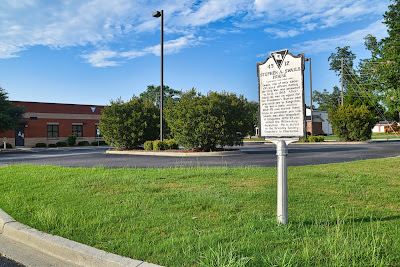It's 2020 and already there are news stories about the decennial (every 10 years) census that the U.S. Department of Commerce will oversee later this year. Census data are used as benchmarks for a number of things. We most often hear that these figures determine the districts for the U.S. House of Representatives, but they are also used to determine districts for local bodies like county councils, town councils, and school boards. They also play a role in determining funding amounts for certain federal programs. Genealogists and those interested in tracing their family history are indebted to census records from 1790-1940 to help them place members of families. But, a close look at census records can also provide a great deal of context to what was going on in a community at a given time.
Digitized records provide access to the census from 1790-1940, with the
exception of 1890, which was burned in a fire in Washington, DC.
Over the last couple of weeks, I've taken a close look at the 1860, 1870, and 1880 censuses for Kingstree, looking primarily at age, occupation and birthplace. I suppose it should not be surprising that Kingstree's population was generally on the young side. In 1860, E.O. Frierson, an Old School Presbyterian clergyman, was 28; attorney J.G. Presley was 27; Laura Benjamin, teacher, was 20; S.W Maurice, attorney, was 25; Robert Henry, physician, was 29; S.J. Carter, listed as hotel keeper, was 32; Henry McElveen, fisherman, was 20; Gordon Belcer, dentist, was 22.
Several of the older citizens listed in the 1860 census were Dr. James Bradley, age 70; Robert Deston, 59, who was an English-born school teacher; W.C. Footman, 64, was postmaster. Fifty-three-year old A.A. McKinsey, a native of North Carolina, listed his occupation as saddler. His 17-year-old son, Henry, worked as his apprentice.
The 1870 Census is very important because that was the first time African-American citizens were listed by name. While many of them were farmers and farm labor, a number had become tradespeople, serving as barbers, laundresses, seamstresses, blacksmiths, railroad workers, coopers (barrel makers) and school teachers. Some of their names and ages are Elvira Brockington, 35; Dinah Staggers, 60; Daniel Staggers, 12; Pauline Pendergrass, 14; Sam Blakeley, 19; Elvira Footman, 30; Maria Bradley, 22; Marla Singleton, 40; Robert Singleton, 16; Gadsden McKnight, 24; Phil Fulton, 22; and Nancy Mouzon, 46. H.W Hampton, 46, and Benjamin Roberts, 49, were black clergymen serving in the community.
Stephen Atkins Swails
The census records can also help trace a person's employment history. For example, Stephen A. Swails, who holds the distinction as Kingstree's first African-American mayor and State Senator, came to South Carolina with the 54th Massachusetts during the Civil War. He settled in Kingstree after the war and is listed as County Auditor in 1870. By 1880, he lists his profession as attorney.
The historical marker on E. Main Street, marking the site where S.A. Swails' house once stood.
Kingstree during the mid-to-late 1800s was the home of many transplants. In 1860, E. Simmes was a 59-year-old brick mason from England, living in Kingstree. Twenty-five-year old Eunice Dodd from New Jersey was a school teacher. A number of Prussian and Bavarian natives ran businesses in Kingstree in those years, including Morris Schwartz, 29; S. Doffens, 27; J.C. Gewinner, 45; Solomon Link, 29; Louis Donath, 32; Philip Heller, 59; Solomon Beutschner, 25; Louis Bergamann, 38; William Stach, 39; Barbara Gewinner, 42; C. Hoffman, 37; J. Beltzer, 56; and Louis Jacobs, 38.
The home of Louis Donath, who was a carpenter. This house once stood where
Kingstree First Baptist Church is today on Academy Street. The house was used
by Laura Pugh as an art studio in the years after the Donaths vacated it.
Some entries tease at what stories lie behind the person's settling in Kingstree. Several examples include 26-year-old blacksmith Edward McMann from Canada; 42-year-old Madison Carter, an African-American cooper who was born in Virginia; and Irish-born, 63-year-old John E. Mack who listed his occupation as gardener. One also wonders how 39-year-old silversmith Charles Moran landed in Kingstree to be counted in the 1880 census.
The census can also be used to verify information. As an example, my May 8, 2019, post, "Childhood Memories of Railroad Trains, recounted the recollections of J.H. Hogans, a Pullman porter, of his early life in Kingstree, watching the trains go by. The 1880 census shows five-year-old James H. Hogans living with his father Alex, a blacksmith, and his mother Margaret.
It can also disprove conventional wisdom. By the early 1900s, many people in Kingstree were under the impression that George Coleman, who had long run the Coleman Hotel in downtown Kingstree, had come here from England to open the hotel shortly after the railroad opened up the area to travelers. Coleman may have come to Kingstree in the late 1850s, but he is listed on the 1860 census as a ditcher and in 1870 as a farmer. By1880, he is a merchant/farmer. Another Englishman, Joseph Watson, is living with the Colemans in 1880, and his occupation is clerk in bar. So, perhaps Mr. Coleman had by that time acquired the Coleman House, although Philip Heller is listed as hotel keeper in the same census.
While there are errors in the census records, and the handwriting of some of the enumerators is extremely difficult to read, making it likely that other errors have crept in, the census is still a valuable tool for learning about a community on a given date in history.




No comments:
Post a Comment